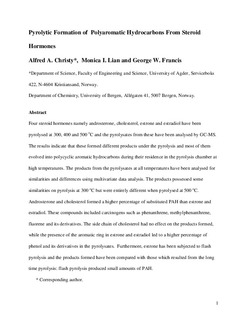Pyrolytic formation of polyaromatic hydrocarbons from steroid hormones
Journal article, Peer reviewed
Permanent lenke
http://hdl.handle.net/11250/138256Utgivelsesdato
2011Metadata
Vis full innførselSamlinger
Originalversjon
Christy, A. A., Lian, M. I., & Francis, G. W. (2011). Pyrolytic formation of polyaromatic hydrocarbons from steroid hormones. [Article]. Food Chemistry, 124(4), 1466-1472. doi: 10.1016/j.foodchem.2010.07.109Sammendrag
Four steroid hormones, namely androsterone, cholesterol, estrone and estradiol, have been pyrolysed at 300, 400 and 500 °C and the pyrolysates from these have been analysed by GC-MS. The results indicate that these formed different products under the pyrolysis and most of them evolved into polycyclic aromatic hydrocarbons during their residence in the pyrolysis chamber at high temperatures. The products from the pyrolysates, at all temperatures, were analysed for similarities and differences using multivariate data analysis. The products possessed some similarities on pyrolysis at 300 °C but were entirely different when pyrolysed at 500 °C. Androsterone and cholesterol formed a higher percentage of substituted PAH than did estrone and estradiol. These compounds included carcinogens, such as phenanthrene, methylphenanthrene, fluorene and its derivatives. The side chain of cholesterol had no effect on the products formed, while the presence of the aromatic ring in estrone and estradiol led to a higher percentage of phenol and its derivatives in the pyrolysates. Furthermore, estrone was subjected to flash pyrolysis and the products formed were compared with those which resulted from the long time pyrolysis: flash pyrolysis produced small amounts of PAH.
Beskrivelse
Author's version of an article published in Food Chemisty, 124 (4), 1466-1472. Also available from the publisher: hhtp://dx.doi.org/10.1016/j.foodchem.2010.07.109
